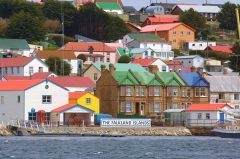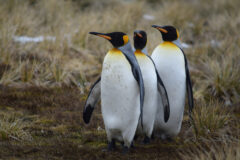Where to go when - our guide to Falkland Islands
September - October
With the arrival of spring, and mating season with it, September - October is the very earliest that nature lovers might consider visiting, Average temperatures are a chilly 9°C, there’s less sunshine than in the following months and wildlife colonies have yet to reach maximum numbers. But the wildlife spectacle is nevertheless underway; Gentoo and Magellanic penguins arrive in Sep and lay eggs in early Oct which is when Rockhopper penguins arrive and all four species of penguin can be seen (the colourful King Penguins are permanent residents on the islands). Black-Browed Albatross, Seal Lions and gigantic Elephant Seal bulls can also be seen, the latter engaging in ferocious fights to control their harems. Sep and Oct are considered excellent for fly fishing.
9°C Average max daytime temperature
0°C Average min nighttime temperature
9 days per season rainfall
None humidity

November - February
These are the best months to visit. By November it’s warmer, with an average temperature of 12°C, rising to 14-15°C in January and February. But even in these peak summer months you can expect constantly changing weather conditions, from clear sunny spells one moment to fast encroaching moody skies and showers the next although overall there’s a good amount of sunshine and not too much rain. Black-Browed Albatross, King Cormorants and all the four species of penguin can be seen in large noisy colonies. Cute fluffy brown King Penguin chicks can be seen alongside the colourful adults most of the year but Gentoo, Magellanic and Rockhopper chicks hatch in late November/early December. At this time glassy eyed Elephant Seal pups are learning to swim whilst Sea Lions pups are born later in January. By mid February, although still suckling, they start to play in the shallow pools within dangerous striking distance of the odd opportunistic Orca patrolling the shoreline.
12°C Average max daytime temperature
4°C Average min nighttime temperature
11 days per season rainfall
None humidity

March - April
March sees the arrival of the autumn in the Falklands, days get shorter, there are fewer hours of sunshine, winds pick up considerably and temperatures drop to an average of 12°C in March and 8°C in April. The wildlife experience is still good in March but by mid April much of the wildlife has left, as well as most tourists. Penguin chicks fledge in March as adults moult in preparation to head out to sea, leaving the islands for the winter months. Elephant Seals and Southern Sea Lions have also all but gone by April. King Penguins remain all year as do about half the island’s Gentoo population, along with many of the smaller bird species. These months are considered the best for fly fishing, alongside September and October.
11°C Average max daytime temperature
3°C Average min nighttime temperature
11 days per season rainfall
None humidity

May - August
Unless you have a specific reason, it’s best to avoid visiting the Falklands during these cold winter months. The prevailing westerly winds are at their strongest and add a bitter chill-factor to the low average temperatures, which range between of 6°C and 2°C during the winter. Although smaller birds, King Penguins and about 50% of the island’s Gentoo penguin population can be seen the majority of the wildlife has left and doesn’t return until after the winter. Those interested in war history might like to be present for Liberation Day on 14th Jun to attend church services and military parades to commemorate the 1982 conflict.
6°C Average max daytime temperature
-1°C Average min nighttime temperature
10 days per season rainfall
None humidity

Papagaio
Your edit for Latin American inspiration
Our exciting range of articles on Latin America explore everything from iconic destinations and lesser-known cultural gems to delicious traditional recipes. You’ll also find exclusive travel tips, first-hand client reviews and the chance to get your personal questions answered by our travel experts.
View Extraordinary Inspiration






































